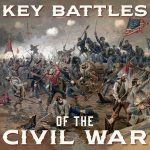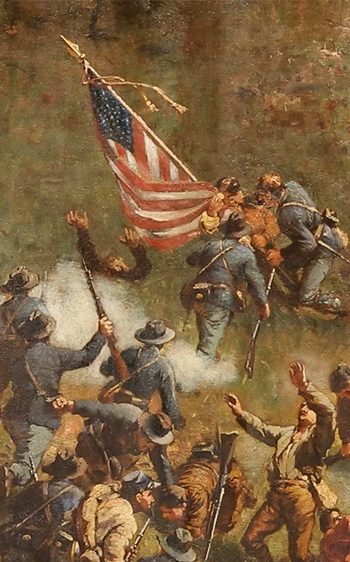Loading...
In the fall of 1864, the Union Army now had full momentum against the Confederacy, pushing deeper into the South than ever before. General Sherman overwhelmed forces led by John Bell Hood. With the fall of Atlanta, Lincoln nearly assured his re-election in 1864.
Changes after Chattanooga
- After the Union victory in November 1863, there was very little action anywhere, east or west.
- Joseph Johnston had replaced Braxton Bragg as commander of all western Confederate forces.
- Ulysses S. Grant, commander of all Union forces in the west, came up with a strategy called “Exhaustion.” This meant destroying the enemy’s ability to make war…the transportation network, the industrial capacity, and the ability to produce food. (It is not the same as a strategy of “attrition.”)
- Grant decided not to try and occupy large areas of the Confederacy. This would take too many men and resources.
- Sherman marched his army to Meridian, MS, living off the land and destroying much of what was in their path. This proved that “exhaustion” worked.
Grant’s Promotion and Plan
- On March 2, 1864, Lincoln promoted Grant to Lieutenant General and named him General-in-Chief of all U. S. Armies. (Halleck was demoted to “Chief of Staff.”) Grant made his headquarters with the Army of the Potomac rather than in Washington.
- In the East, Grant would not attempt to carry out a strategy of exhaustion. Lee’s army itself would be his target.
- Grant came up with a 5-part strategy:
- Nathaniel Banks would march on Mobile, take it, then move eastward toward Georgia. There were no significant Confederate armies in the area.
- Sherman, who Grant put in charge of all western armies, would march toward and take Atlanta. Johnston stood in Sherman’s way.
- The Army of the Potomac would attack Lee’s army, forcing him back toward Richmond and preventing him from reinforcing Johnston.
- Benjamin Butler, now on the Peninsula and in command of the Army of the James, would march up toward Richmond from the southeast.
- Franz Sigel, who had an army of 6500 in West VA, would march into the Shenandoah Valley, commandeer its resources, and disrupt communications with the valley and Lee’s army.
- Regarding Butler and Sigel, Lincoln said “those not skinning can hold a leg.”
- Banks never even launched the attack on Mobile. Instead he moved up the Red River in an attempt to invade Texas. This effort failed.
- We will discuss how Butler and Sigel did in a future episode.
Toward Atlanta
-
-
-
- (Sherman bio; WP, no Mex. War, failure as banker, head of LA Mil. Acad, later had a breakdown while commander in KY) Sherman and Grant’s relationship)
- Sherman to Grant: “We cannot change the hearts of the people of the South. We can make war so terrible that they will realize its folly.”
- At Chattanooga, Sherman commanded what today we could call an “Army Group.”
- The Army of the Cumberland, under George Thomas (60,000)
- The Army of the Tennessee, under James B. McPherson (25,000)
- The Army of the Ohio, under John Schofield (15,000)
- The Confederate Army of Tennessee, with 65,000 stood between Sherman and Atlanta. Johnston’s corps commanders were William Hardee, John Bell Hood, and Leonidas Polk. The army grew to 80,000 over the next few weeks.
- Throughout May, Sherman repeatedly tried to turn Johnston’s flank, and Johnston gradually retreated. The Federals lost an opportunity to seriously damage the Confederates at Resaca due to McPherson moving too slowly and cautiously. Sherman tells him “Mac, you missed the opportunity of a lifetime.”
- Sherman’s forces were constantly harassed by Confederate cavalry under Nathan Bedford Forrest. Sherman said “Forrest must be hunted down and killed if it costs 10,000 lives and bankrupts the Federal treasury.”
- By May 25, Johnston had retreated to New Hope Church, about 35 miles north of Atlanta. Heavy skirmishing took place there.
- By the second week of June, they had reached Marietta. There Johnston had his right flank anchored on Kennesaw Mountain.
- Both sides built entrenchments every time they stopped. This had become standard procedure. Confederates joked that the Federals marched with a rifle in one hand and a shovel in the other. The Federals countered that the Rebels seemed to carry their breastworks with them.
- Polk was killed on June 14 at Pine Mountain.
- On June 27, Sherman ordered an assault on the Confederate forces at Kennesaw Mountain. Johnston easily repulsed the attack, causing the Yankees to have 3000 casualties compared to only 600 for the Confederates. “The Federals seemed to walk up and take death as coolly as if they were automatic or wooden men,” one Confederate soldier wrote.
- Only July 2, Sherman flanks Johnston’s army again, forcing it to retreat. Johnston orders the evacuation of Atlanta’s hospitals and munitions factories.
- On July 9, Sherman crosses the Chattahooche River. Johnston and his army retreated to a defensive position just outside Atlanta. Many Confederates believed Johnston had given up too much ground without a fight. They saw this as a pattern. During their long retreat, the Confederates had lost about 15,000 men.
- Chaos broke out in the city as people fled for saver environs. In the previous year, Atlanta’s population had decreased from 20,000 to 4000. Mostly white women and slaves were left.
- Johnston and the army constantly built entrenchments. Sherman wrote “The enemy must have 50 miles of connected trenches. The whole country is one vast fort.”
- On July 17, Davis removed Johnston from command and replaced him with John Bell Hood. Hood had lost the use of an arm at Gettysburg and a leg at Chickamauga. He had been scheming behind Johnston’s back to get his job.
- This made Hardee very upset, because he was senior to Hood. He later requested a transfer and founded a fast-food chain.
-
-
The Battle for Atlanta
- Hood was pressured by Davis and other Confederate leaders to go on the offensive.
- Sherman advanced toward Atlanta in three columns (one for each army). He sent McPherson to go around to the east and attempt a turning movement.
- On July 20, Hood sent two corps against Thomas’ army (on the Union right). They clashed in the Battle of Peachtree Creek. There were 2000 Federal and 2500 Confederate casualties. It was a draw.
- Next, Hood tried a flanking movement against the Union left (the east). He sent Hardee on a long, 15 mile march toward the extreme Union left. The two sides clashed on July 22 at the “Battle of Atlanta.”
- The battle was indecisive. Hood suffered 8000 casualties, while the Federals only had 2000. McPherson was mortally wounded. He was succeeded by Oliver O. Howard.
- When Sherman heard of McPherson’s death, he wept openly. Even Hood grieved, for he had been McPherson’s roommate at West Point. Hood wrote “I will record the death of my classmate and boyhood friend, General James B. McPherson, the announcement of which caused me sincere sorrow.”
- Peachtree Creek and the Battle of Atlanta did halt Sherman’s advance, at least for a while.
- On July 25-27, Sherman shifted his entire army westward.
- Hood decided to hit the Federals while they were in motion. Hood ordered an attack on Howard’s army which took place at Ezra Church. The Federals anticipated this and threw back the attacking Confederates. The rebels lost 3000, but the Federals lost only 600. The battle was a failure, but it did prevent the Federals from cutting the rail lines from Atlanta.
- The battles of Peachtree Creek, Atlanta, and Ezra Church destroyed the offensive capability of the Confederate army. Hood had lost 20,000 men, and his army was demoralized.
- Sherman was pleased. He said “I’m glad when they attack, for the advantage is with us.”
- Sherman orders a bombardment of the city that would last 5 weeks. By late August, about 30,000 shells had landed in the city.
- Afterward, Sherman sent a force south of the city to cut the rail lines. Hood sent two corps to stop the Federals on August 31 (Battle of Jonesboro), but they failed. Hood had no choice but to evacuate, since his last line of supply was cut.
- Hood and his army evacuated on September 1 and 2, burning or blowing up everything of military value before they left. Sherman marched into the city on the 2nd. Sherman wired Lincoln, “Atlanta is ours, and fairly won.”
- Northern morale soared. The fall of Atlanta probably saved Lincoln’s reelection hopes.
 Would you like to learn the complete history of the Civil War? Click here for our podcast series Key Battles of the Civil War
Would you like to learn the complete history of the Civil War? Click here for our podcast series Key Battles of the Civil War
Cite This Article
"The Battle of Atlanta" History on the Net© 2000-2024, Salem Media.
April 25, 2024 <https://www.historyonthenet.com/the-battle-of-atlanta>
More Citation Information.






